

Mereology. Mereology has been axiomatized in various ways as applications of predicate logic to formal ontology, of which mereology is an important part.
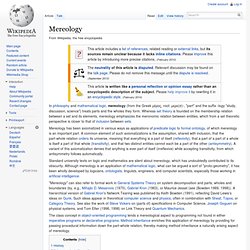
A common element of such axiomatizations is the assumption, shared with inclusion, that the part-whole relation orders its universe, meaning that everything is a part of itself (reflexivity), that a part of a part of a whole is itself a part of that whole (transitivity), and that two distinct entities cannot each be a part of the other (antisymmetry). A variant of this axiomatization denies that anything is ever part of itself (irreflexive) while accepting transitivity, from which antisymmetry follows automatically. Standard university texts on logic and mathematics are silent about mereology, which has undoubtedly contributed to its obscurity. History[edit] A.N. Holographic principle. In a larger sense, the theory suggests that the entire universe can be seen as a two-dimensional information structure "painted" on the cosmological horizon[clarification needed], such that the three dimensions we observe are an effective description only at macroscopic scales and at low energies.

Cosmological holography has not been made mathematically precise, partly because the particle horizon has a finite area and grows with time.[4][5] The holographic principle was inspired by black hole thermodynamics, which conjectures that the maximal entropy in any region scales with the radius squared, and not cubed as might be expected.
Direct and indirect realism. Naïve realism argues we perceive the world directly.
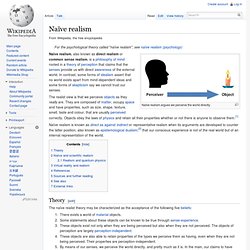
Geometrical frustration. In condensed matter physics, the term geometrical frustration (or in short: frustration [1]) refers to a phenomenon, where atoms tend to stick to non-trivial positions or where, on a regular crystal lattice, conflicting inter-atomic forces (each one favoring rather simple, but different structures) lead to quite complex structures.
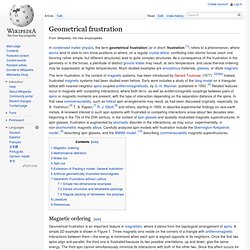
As a consequence of the frustration in the geometry or in the forces, a plenitude of distinct ground states may result, at zero temperature, and usual thermal ordering may be suppressed, at higher temperatures. Much studied examples are amorphous materials, glasses, or dilute magnets. Magnetic ordering[edit] Similarly in three dimensions, four spins arranged in a tetrahedron (Figure 2) may experience geometric frustration. If there is an antiferromagnetic interaction between spins, then it is not possible to arrange the spins so that all interactions between spins are antiparallel.
Figure 1: Antiferromagnetically interacting spins in a triangular arrangement. Neutral monism. Neutral monism, in philosophy, is the metaphysical view that the mental and the physical are two ways of organizing or describing the same elements, which are themselves "neutral", that is, neither physical nor mental.
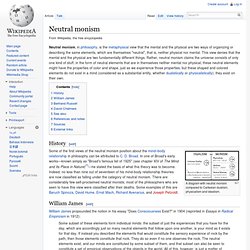
This view denies that the mental and the physical are two fundamentally different things. Unobservable. "Unobservables" is a reference similar to Immanuel Kant's distinction between noumena (things-in-themselves, i.e., raw things in their necessarily unknowable state,[1] before they pass through the formalizing apparatus of the senses and the mind in order to become perceived objects) and phenomena (the perceived object).
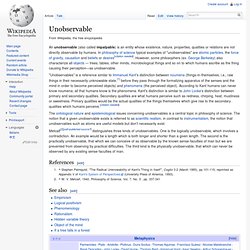
According to Kant humans can never know noumena; all that humans know is the phenomena. Kant's distinction is similar to John Locke's distinction between primary and secondary qualities. Secondary qualities are what humans perceive such as redness, chirping, heat, mustiness or sweetness. Primary qualities would be the actual qualities of the things themselves which give rise to the secondary qualities which humans perceive. [citation needed] The ontological nature and epistemological issues concerning unobservables is a central topic in philosophy of science.
Metcalf[2][self-published source?] References[edit] See also[edit] String-net liquid. In condensed matter physics, a string-net is an extended object whose collective behavior has been proposed as a physical mechanism for topological order by Michael A.
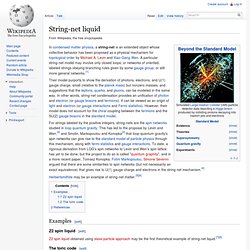
Levin and Xiao-Gang Wen. A particular string-net model may involve only closed loops; or networks of oriented, labeled strings obeying branching rules given by some gauge group; or still more general networks.[1] Their model purports to show the derivation of photons, electrons, and U(1) gauge charge, small (relative to the planck mass) but nonzero masses, and suggestions that the leptons, quarks, and gluons, can be modeled in the same way. In other words, string-net condensation provides an unification of photon and electron (or gauge bosons and fermions). It can be viewed as an origin of light and electron (or gauge interactions and Fermi statistics). For strings labeled by the positive integers, string-nets are the spin networks studied in loop quantum gravity. Examples[edit] Z2 spin liquid[edit] The toric code[edit] Direct and indirect realism. Direct realism argues we perceive the world directly History[edit] Aristotle was the first to provide a description of direct realism.
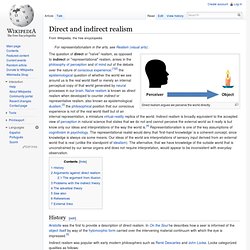
In On the Soul he describes how a seer is informed of the object itself by way of the hylomorphic form carried over the intervening material continuum with which the eye is impressed.[5] Indirect realism was popular with early modern philosophers such as René Descartes and John Locke. Locke categorized qualities as follows: Primary qualities are qualities which are 'explanatorily basic' - which is to say, they can be referred to as the explanation for other qualities or phenomena without requiring explanation themselves - and they are distinct in that our sensory experience of them resembles them in reality.
In contemporary philosophy, epistemological dualism has come under sustained attack by philosophers like Wittgenstein (the private language argument) and Wilfrid Sellars in his seminal essay "Empiricism and the Philosophy of Mind. " Implicate and explicate order according to David Bohm. Implicate order and explicate order are concepts coined by David Bohm to describe two different frameworks for understanding the same phenomenon or aspect of reality.

He uses these notions to describe how the same phenomenon might look different, or might be characterized by different principle factors, in different contexts such as at different scales. The implicate order, also referred to as the "enfolded" order, is seen as a deeper and more fundamental order of reality. In contrast, the explicate or "unfolded" order include the abstractions that humans normally perceive. As he writes: Simeon Alev: Look for Truth No Matter Where It Takes You. Bohmian Mechanics at the University of Innsbruck. Bohmian Mechanics at the University of Innsbruck. Quantum Entanglement and Information.
First published Mon Aug 13, 2001; substantive revision Thu Aug 26, 2010 Quantum entanglement is a physical resource, like energy, associated with the peculiar nonclassical correlations that are possible between separated quantum systems.

Entanglement can be measured, transformed, and purified. A pair of quantum systems in an entangled state can be used as a quantum information channel to perform computational and cryptographic tasks that are impossible for classical systems. Bohmian Mechanics. First published Fri Oct 26, 2001; substantive revision Mon Mar 4, 2013.